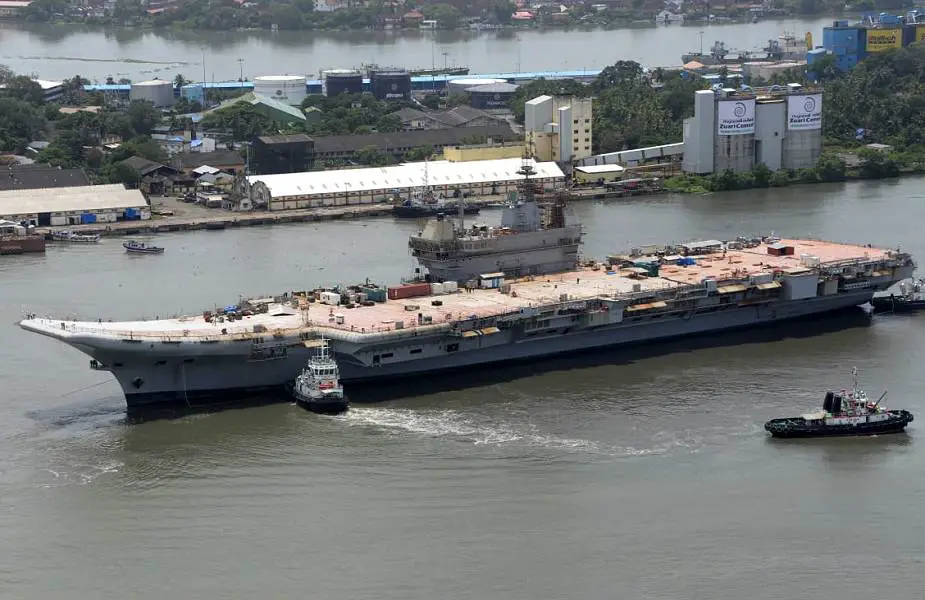According to information published by Indian newspapers, on December 1, 2020, India has successfully completed basin trials of its local-made Indigenous Aircraft Carrier (IAC) INS Vikrant at Cochin Shipyard Limited (CSL) on Monday, November 30, 2020.
According to information published by Indian newspapers, on December 1, 2020, India has successfully completed basin trials of its local-made Indigenous Aircraft Carrier (IAC) INS Vikrant at Cochin Shipyard Limited (CSL) on Monday, November 30, 2020.
Follow Navy Recognition on Google News at this link
 Indigenous Aircraft Carrier (IAC) INS Vikrant during basin trials at Cochin Shipyard Limited. (Picture source Twitter account PRO Defence Kochi)
Indigenous Aircraft Carrier (IAC) INS Vikrant during basin trials at Cochin Shipyard Limited. (Picture source Twitter account PRO Defence Kochi)
Citing the "The New Indian Express" website, As part of the trials, all four LM2500 gas turbines, main gearboxes, shafting and controllable pitch propellers, and the integrated control systems were successfully operated. Major auxiliary equipment and systems such as the steering gear, air-conditioning plants centrifuges, power generation and distribution system, and internal communication equipment were also tested.
The Indigenous Aircraft Carrier 1 (IAC-1) launched under the name of INS Vikrant is the first aircraft carrier built in India by Cochin Shipyard in Kochi, Kerala for the Indian Navy. The design of the ship started in 1999 and the keel was laid in February 2009. The carrier was floated out of its dry dock on 29 December 2011 and was launched on 12 August 2013.
The INS Vikrant has a length of 262 m, a wide of 62 m, and a displacement of 39,000 tons. Shee features a STOBAR (Short Take-Off But Arrested Recovery) configuration with a ski-jump. STOBAR ("Short Take-Off But Arrested Recovery" or "Short Take-Off, Barrier Arrested Recovery") is a system used for the launch and recovery of aircraft from the deck of an aircraft carrier, combining elements of "short take-off and vertical landing" (STOVL) with "catapult-assisted take-off but arrested recovery" (CATOBAR). Aircraft launch under their own power using a ski-jump to assist take-off (rather than using a catapult). However, the planes are conventional, rather than STOVL aircraft, and thus require arrestor wires to land on the ship. The STOBAR system is simpler to build than CATOBAR. As of 2018, it has been used regularly on Russian, Indian, and Chinese carriers.
The INS Vikrant is powered by four General Electric LM2500 gas turbines and two Elecon COGAG gearbox. She can reach a top speed of 28 knots (52 km/h; 32 mph) with a maximum cruising range of 8,000 nautical miles (15,000 km; 9,200 mi). This aircraft carrier has a crew of 1,645 sailors including 196 officers.
According to Indian Navy sources, the INS Vikrant is able to carry 36 to 40 fixed-wing aircraft including 26 fighter aircraft Mikoyan MiG-29K and 10 helicopters including Kamov Ka-31, Westland Sea King, and HAL Dhruv, a utility helicopter designed and developed by the Indian company Hindustan Aeronautics Limited (HAL). The Ka-31 will fulfill the airborne early warning (AEW) role and the Sea King will provide anti-submarine warfare (ASW) capability.
The armament of the INS Vikrant includes four Otobreda 76 mm (3 in) dual-purpose naval guns, 2x32 VLS (Vertical launching System) Barak 1 & Barak 8 surface-to-air missile launchers and Russian-made AK-630 CIWS (Close-In Weapon Systems) based on a six-barreled 30 mm rotary cannon.







